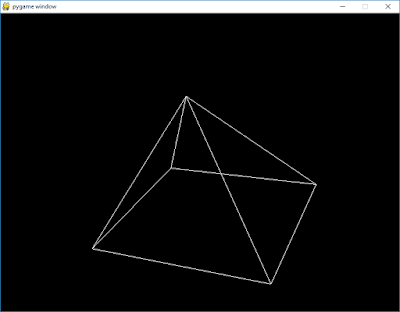
1. Grafica de Barras en 3D
from mpl_toolkits.mplot3d import Axes3D
import matplotlib.pyplot as plt
fig = plt.figure()
ax1 = fig.add_subplot(111, projection='3d')
xpos = [1,2,3,4,5,6,7,8,9,10,11,12,13,14,15]
ypos = [2,3,4,5,1,6,2,1,7,2,3,5,1,3,2]
num_elements = len(xpos)
zpos = [0,0,0,0,0,0,0,0,0,0,0,0,0,0,0]
dx = dy =dz = [20,2,3,4,5,6,7,8,9,10,11,12,13,14,15]
ax1.bar3d(xpos, ypos, zpos, dx, dy, dz, color='red')
plt.show()

2. Cubo 3D
import pygame
from pygame.locals import *
from OpenGL.GL import *
from OpenGL.GLU import *
verticies = (
(1, -1, -1),
(1, 1, -1),
(-1, 1, -1),
(-1, -1, -1),
(1, -1, 1),
(1, 1, 1),
(-1, -1, 1),
(-1, 1, 1)
)
edges = (
(0,1),
(0,3),
(0,4),
(2,1),
(2,3),
(2,7),
(6,3),
(6,4),
(6,7),
(5,1),
(5,4),
(5,7)
)
def Cube():
glBegin(GL_LINES)
for edge in edges:
for vertex in edge:
glVertex3fv(verticies[vertex])
glEnd()
def main():
pygame.init()
display = (800,600)
pygame.display.set_mode(display, DOUBLEBUF|OPENGL)
gluPerspective(45, (display[0]/display[1]), 0.1, 50.0)
glTranslatef(0.0,0.0, -5)
while True:
for event in pygame.event.get():
if event.type == pygame.QUIT:
pygame.quit()
quit()
glRotatef(1, 3, 1, 1)
glClear(GL_COLOR_BUFFER_BIT|GL_DEPTH_BUFFER_BIT)
Cube()
pygame.display.flip()
pygame.time.wait(10)
main()
3. Figura 3D de colores
import sys, math, pygame
from operator import itemgetter
class Point3D:
def __init__(self, x=0, y=0, z=0):
self.x, self.y, self.z = float(x), float(y), float(z)
def rotateX(self, angle):
""" Rotates the point around the X axis by the given angle in degrees. """
rad = angle * math.pi / 180
cosa = math.cos(rad)
sina = math.sin(rad)
y = self.y * cosa - self.z * sina
z = self.y * sina + self.z * cosa
return Point3D(self.x, y, z)
def rotateY(self, angle):
""" Rotates the point around the Y axis by the given angle in degrees. """
rad = angle * math.pi / 180
cosa = math.cos(rad)
sina = math.sin(rad)
z = self.z * cosa - self.x * sina
x = self.z * sina + self.x * cosa
return Point3D(x, self.y, z)
def rotateZ(self, angle):
""" Rotates the point around the Z axis by the given angle in degrees. """
rad = angle * math.pi / 180
cosa = math.cos(rad)
sina = math.sin(rad)
x = self.x * cosa - self.y * sina
y = self.x * sina + self.y * cosa
return Point3D(x, y, self.z)
def project(self, win_width, win_height, fov, viewer_distance):
""" Transforms this 3D point to 2D using a perspective projection. """
factor = fov / (viewer_distance + self.z)
x = self.x * factor + win_width / 2
y = -self.y * factor + win_height / 2
return Point3D(x, y, self.z)
class Simulation:
def __init__(self, win_width=640, win_height=480):
pygame.init()
self.screen = pygame.display.set_mode((win_width, win_height))
pygame.display.set_caption("Figura de cubo 3D en python")
self.clock = pygame.time.Clock()
self.vertices = [
Point3D(-1, 1, -1),
Point3D(1, 1, -1),
Point3D(1, -1, -1),
Point3D(-1, -1, -1),
Point3D(-1, 1, 1),
Point3D(1, 1, 1),
Point3D(1, -1, 1),
Point3D(-1, -1, 1)
]
# Define the vertices that compose each of the 6 faces. These numbers are
# indices to the vertices list defined above.
self.faces = [(0, 1, 2, 3), (1, 5, 6, 2), (5, 4, 7, 6), (4, 0, 3, 7), (0, 4, 5, 1), (3, 2, 6, 7)]
# Define colors for each face
self.colors = [(255, 0, 100), (100, 0, 0), (0, 25, 0), (0, 0, 255), (0, 255, 155), (255,5, 0)]
self.angle = 0
def run(self):
""" Main Loop """
while 1:
for event in pygame.event.get():
if event.type == pygame.QUIT:
pygame.quit()
sys.exit()
self.clock.tick(50)
self.screen.fill((0, 32, 0))
# It will hold transformed vertices. \
t = []
for v in self.vertices:
# Rotate the point around X axis, then around Y axis, and finally around Z axis.
r = v.rotateX(self.angle).rotateY(self.angle).rotateZ(self.angle)
# Transform the point from 3D to 2D
p = r.project(self.screen.get_width(), self.screen.get_height(), 256, 4)
# Put the point in the list of transformed vertices
t.append(p)
# Calculate the average Z values of each face.
avg_z = []
i = 0
for f in self.faces:
z = (t[f[0]].z + t[f[1]].z + t[f[2]].z + t[f[3]].z) / 4.0
avg_z.append([i, z])
i = i + 1
# Draw the faces using the Painter's algorithm:
# Distant faces are drawn before the closer ones.
for tmp in sorted(avg_z, key=itemgetter(1), reverse=True):
face_index = tmp[0]
f = self.faces[face_index]
pointlist = [(t[f[0]].x, t[f[0]].y), (t[f[1]].x, t[f[1]].y),
(t[f[1]].x, t[f[1]].y), (t[f[2]].x, t[f[2]].y),
(t[f[2]].x, t[f[2]].y), (t[f[3]].x, t[f[3]].y),
(t[f[3]].x, t[f[3]].y), (t[f[0]].x, t[f[0]].y)]
pygame.draw.polygon(self.screen, self.colors[face_index], pointlist)
self.angle += 1
pygame.display.flip()
if __name__ == "__main__":
Simulation().run()
4. Triangulo
import pygame
from pygame.locals import *
from OpenGL.GL import *
from OpenGL.GLU import *
verticies = (
(1, -1, -1),
(1, 1, -1),
(-1, 1, -1),
(-1, -1, -1),
(0,0,1)
)
edges = (
(4,0),
(4,1),
(4,2),
(4,3),
(0,1),
(0,3),
(2,1),
(2,3)
)
def Cube():
glBegin(GL_LINES)
for edge in edges:
for vertex in edge:
glVertex3fv(verticies[vertex])
glEnd()
def main():
pygame.init()
display = (800,600)
pygame.display.set_mode(display, DOUBLEBUF|OPENGL)
gluPerspective(45, (display[0]/display[1]), 0.1, 50.0)
glTranslatef(0.0,0.0, -5)
while True:
for event in pygame.event.get():
if event.type == pygame.QUIT:
pygame.quit()
quit()
glRotatef(1, 3, 1, 1) #Velocidad, X,Y,Z
glClear(GL_COLOR_BUFFER_BIT|GL_DEPTH_BUFFER_BIT)
Cube()
pygame.display.flip()
pygame.time.wait(10)
main()



Comments
Post a Comment